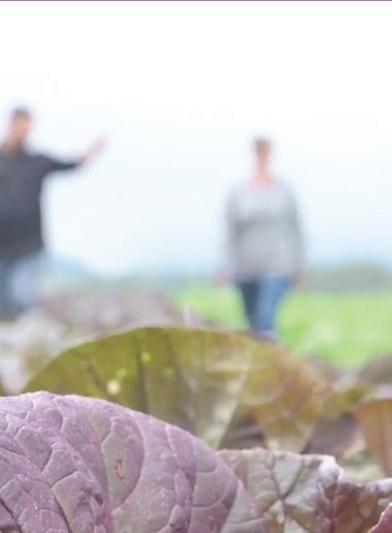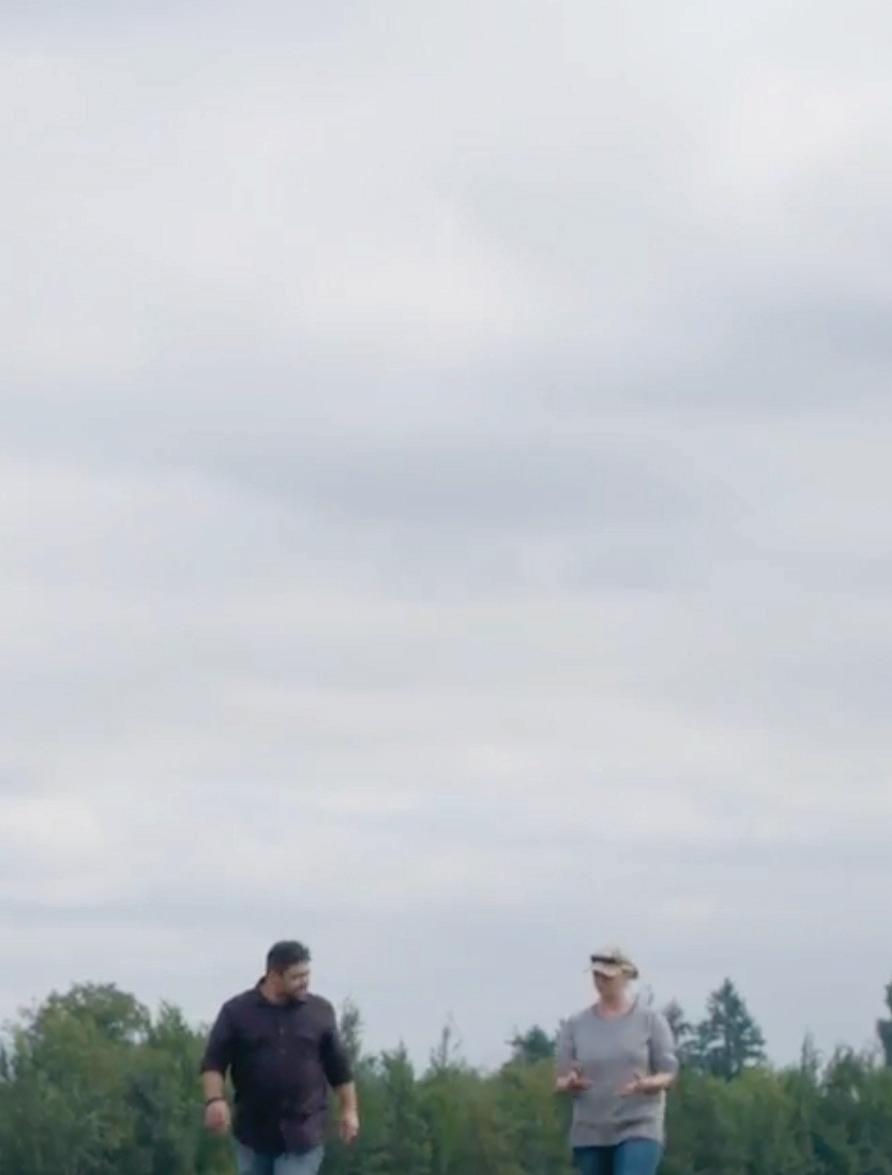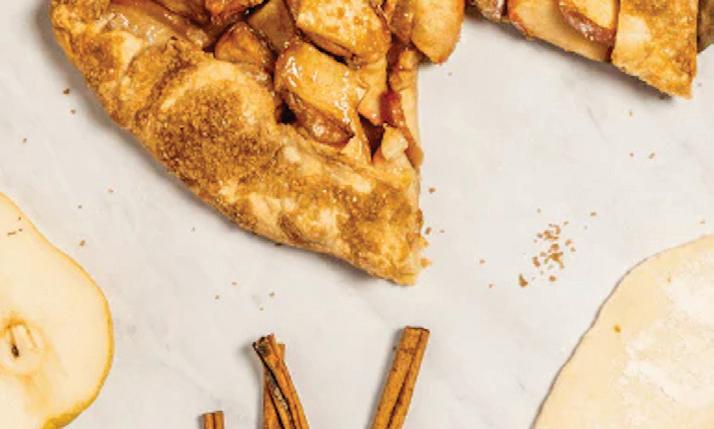




magazine Puzzles and games related to this issue! Skagit Valley farmers growing winter veggies A sweet treat at Seattle’s Kitchen & Market Washington state’s first black settler WIN A $25 GIFT CARD
A New Frontier.









2 WASHINGTON GROWN MAGAZINE FEBRUARY 2023
He braved the Oregon Trail in 1844. But he and his family weren’t welcome in the Oregon Territory.
Less than a decade after the Whitmans established their mission at Waiilatpu in southeast Washington, a group of pioneers left Missouri in search of a new life at the end of the Oregon Trail. The co-leader of the group was George Bush, a military man, trapper, wheat farmer and free Black American. He, his wife, Isabella, and their five sons joined friend Michael T. Simmons and three other families on the journey west, eventually settling in current day Tumwater. Tumwater was the first permanent American settlement in Washington.
The journey to this settlement was not without hardships and moral challenges. Historians believe Bush, a seasoned frontiersman and successful farmer, was one of the wealthiest pioneers to enter the territory. The Oregon Territory, however, had recently enacted laws making it illegal for Bush to settle there because of his skin color. Arriving at the Columbia River in the fall of 1844, the group decided to settle only where the Bush family could settle. They spent that winter at Washougal, north of the Columbia River, where the Oregon government’s rule was not enforced. In the summer, Simmons and Bush explored the southern area of the Puget Sound, and in the fall of 1845, their group trekked north along the Cowlitz River. They cut a wagon trail through the forest to Budd Inlet, landing in the spot the Chinook tribe called Tumchuck, meaning “throbbing waters” or waterfall. The families settled in the spot, eventually naming it Tumwater.
Frontier.
The Bush family settled on 640 acres nearby, which became Bush Prairie and was known as one of the most valuable and productive farms in early Washington. With Simmons, Bush built the area’s first gristmill (flour mill) and sawmill. Bush was well known for his compassion and generosity, helping finance Simmons’ logging company, dividing his crops with friends, and maintaining good relations with neighboring tribes.

WASHINGTON GROWN MAGAZINE FEBRUARY 2023 3
In 1846, the northern boundary of the Oregon Territory was extended to the 49th parallel (the modern northern boundary of the State of Washington), and so were its racist laws. Bush’s land claim was suddenly illegal according to the laws of Oregon. Fortunately, Simmons had been appointed a justice of the peace and was able to temporarily prevent the loss of Bush’s claim.

The Bush family lived under these tense circumstances for years, but their loyalty and commitment to their neighbors never wavered. According to historians, in 1852, “the grain supply was low on Puget Sound, and speculators attempted to accumulate the entire wheat crop. They offered Bush a high price for his wheat, but




“I don’t intend to see them want for anything I can provide them”
There are no known photos taken of George Bush. This photo is of his children in front of the house they built at Bush Prairie Farm.
4 WASHINGTON GROWN MAGAZINE FEBRUARY 2023
The Bush Prairie Farm, near Tumwater, became a saving grace for other pioneers to the Puget Sound area. One legend says that Isaac Stevens, the first governor of the Washington territory, stayed at the Bush farm, disguised as a lonely traveler, but Bush and his family would not accept his payment for their services.
Bush told them that he would keep his grain, ‘so my neighbors will have enough to live on and for seeding their fields in the spring. They have no money to pay your fancy prices, and I don’t intend to see them want for anything I can provide them.’” (NPS, 1999)
Historian Ezra Meeker remarked that during this food crisis, “The man divided out nearly his whole crop to new settlers who came with or without money …. ‘Pay me in kind next year,’ he would say to those in need; and to those who had money, he would say, ‘Don’t take too much … just enough to do you,’ and in this wise divided his large crop and became a benefactor to the whole community.” (WSHS, 1994)






The Washington Territory separated from Oregon in 1853. Nine years after settling their farm, a group of Bush’s neighbors and friends passed a memorial through the Washington Territorial Legislature requesting that the United States Congress grant the Bush family title to their land in 1854. The U.S. Congress passed this special act the following year.
Many settlers in the region owed their success to George Bush and his family. George died on April 5, 1863, and Isabella followed three years later. Their sons carried on their tradition of farming and public service. William Owen Bush, their eldest son, was a member of the first Washington State Legislature in 1889-1890 and farmed the Bush Prairie Farm until his death in 1907.


The Bush Prairie Farm is now owned and farmed by Mark and Kathleen Clark, and with the help of the NRCS and Capitol Land Trust, has been preserved as farmland forever. The farm is home to butternut trees and fruit trees that descended from those George and Isabella brought from Missouri.
In November of 2021, a new monument honoring the legacy of George Bush and his family was installed on the Capitol Campus in Olympia, as part of a project to celebrate and share the history of Black Washingtonians. A Bush butternut tree, taken as a sapling from the butternut trees on the Bush Prairie Farm, was planted nearby.

WASHINGTON GROWN MAGAZINE FEBRUARY 2023 5
William Owen Bush, the eldest son of Washington’s first Black pioneer, George Bush, was Washington’s first Black legislator. He served in the first legislature after Washington became a state in 1889 and was instrumental in founding what is now Washington State University.
Meet


the Skagit Valley farmers growing colorful produce ... in the winter.
Washington state has the perfect climate to grow so many marvelous fruits and vegetables for all of us to enjoy. All summer long, we have access to incredible produce in grocery stores and farmers markets. But did you know lots of fresh food is grown during the winter months too?
Nestled in the Skagit Valley, Boldly Grown Farm is one of those places you can find produce grown in the colder months – as well as during the typical warm growing seasons. A certified organic family farm, Boldly Grown Farm specializes in fall and winter storage vegetables for wholesale markets.


















Wife and husband team, Amy Frye and Jacob Slosberg, are using their passion for sustainable food systems to grow all sorts of veggies on their 58-acre farm. “We grow a lot of things that we harvest in the fall and then store and sell like squash and onions, and then other crops that will stay in the ground into February, and then we’ll be harvesting,” says Frye.
As you’ve probably guessed, it’s not typical in most areas of the country to be harvesting crops in the winter. But in this case, it’s all about location. The West Coast, and especially the Skagit region of Washington, provides a mild winter climate allowing Boldly Grown and other farms to take advantage of a variety of produce.
“We grow lots of hardy greens, kale, collards, cabbage, napa cabbage, radicchio is one of our bigger crops, winter squash, carrots, and beets,” says Frye. “You never know what the season’s going to bring, so you always got to be a bit nimble and try to stay flexible.”





There’s no doubt that farmers have to stay flexible – a skill that Boldly Grown Farm has managed to take in stride. In 2015 when Frye and Slosberg set their minds





WASHINGTON GROWN MAGAZINE FEBRUARY 2023 7
to set up roots in the Skagit Valley, they had to be inventive with how they were going to start their own farm. They found Viva Farms – a nonprofit farm business incubator – where they set up shop for seven seasons until they were able to purchase their own land in 2021.



Now on their own farm, Boldly Grown has been able to continue expanding their business providing fresh produce to both the wholesale market and to their own community through their winter CSA program. “We do a mix of really large stuff for people for food processing and then small stuff for grocery stores and the CSA,” says Frye.
The Boldly Grown Farm CSA program is a biweekly offering, through the winter months, to the local community and an opportunity for folks to partner with Frye and Slosberg as stewards of the land. In return for their investment in the farm, CSA members receive high-quality, fresh, healthy produce and become more closely connected to the food they eat.

It’s through these connections that Boldly Grown Farm has made a name for itself in the region. Their focus on growth and sustainability hasn’t narrowed their vision to what a special place in the world we share with each other here in Washington.


“There’s a great diversity of produce that comes from our state all year round. It’s really something to enjoy,” says Slosberg. “It’s awesome!”
And he’s right. All the incredible things grown in this state are so awesome, which includes everything they’re growing at Boldly Grown Farm. You can find their products at the Puget Sound Food Hub, Frank’s Quality Produce, Organically Grown Company, New Seasons Market, Skagit Valley Food Co-op, Community Food Co-op, San Juan Island Food Co-op, Orcas Food Co-op, and at many other restaurants and retailers in Western Washington.
Boldly Grown operates a CSA, or community supported agriculture, a model in which members pay up front for a “share” of the season’s harvest. The farmer uses the funds to help cover the costs of growing the food, and, in return, the member receives a regular supply of produce throughout the season.
KSPS (Spokane)


Mondays at 7:00 pm and Saturdays at 4:30 pm ksps.org/schedule/
KWSU (Pullman)

Fridays at 6:00 pm nwpb.org/tv-schedules/
KTNW (Richland)

Saturdays at 1:00 pm nwpb.org/tv-schedules

KBTC (Seattle/Tacoma)
Saturdays at 6:30 am and 3:00 pm kbtc.org/tv-schedule/
KIMA (Yakima)/KEPR (Pasco)/KLEW (Lewiston)
Saturdays at 5:00 pm kimatv.com/station/schedule / keprtv.com/station/schedule klewtv.com/station/schedule
KIRO (Seattle)
Check local listings kiro7.com

NCW Life Channel (Wenatchee)

Check local listings ncwlife.com

RFD-TV

Thursdays at 12:30 pm and Fridays at 9:00 pm (Pacific) rfdtv.com/
*Times/schedules subject to change based upon network schedule. Check station programming to confirm air times.
wagrown.com @wagrowntv Visit us online!
&
Watch the show online or on your
station
TV
ONLINE
local
Cherry making

KITCHEN & MARKET
10 WASHINGTON GROWN MAGAZINE FEBRUARY 2023
PIKES PLACE
at kitchen & market

Few aromas are more enticing than that of a pie that has just been pulled from the oven. And while pie, as they say, may be easy – even easier is galette. Despite its somewhat fancy-sounding name, a fruit galette is a sort of free-form version of pie. It requires no pie pan, no deft pie dough crimping skills. All it takes is topping a round of pastry dough with fruit and folding the dough’s edges up to enclose it, leaving the center open to showcase the filling.



Kitchen & Market manages to take the degree of ease even further with their fruit galette kits. Each kit contains all the ingredients needed, even parchment paper for your baking sheet. “Basically, we did the grocery shopping for you,” says owner Stephanie King when demonstrating a sour cherry galette on Episode 10 of the new season of Washington Grown, which you can find on wagrown.com. Not only have they done all the shopping, they’ve provided the bonus of including a few components already prepared for you. This includes the all-butter pâte brisée dough, a container of “Magic Pie Spice” that has the perfect blend of seasonings for the filling, and even some whipped cream ready for serving with the gorgeous galette. With the ingredients comes a recipe spelling out the steps for creating the simple but elegant dessert.

WASHINGTON GROWN MAGAZINE FEBRUARY 2023 11 Included in the Fruit Galette Kit 1 Kitchen & Market Pâte Brisée 3 cups Sour Cherries (or other seasonal filling) 1/3 cup Kitchen & Market Magic Pie Spice
Tbsp Turbinado Sugar
cup Kitchen & Market Whipped Cream Parchment Paper All Purpose Flour
in
2
1
Couldn’t be simpler – delicious every time! Simply roll out the dough, toss
your fruit, fold up the edges, and get it into the oven! Galette
In addition to Fruit Galette Kits, Kitchen & Market offers multiple chef-inspired meal kits and prepared foods for order in their stores or through their website. Top: Washington Grown host Kristi Gorenson had a great time making a sour cherry galette in Season 10 with Stephanie King, owner of Kitchen & Market.


Fruits provided in the kits vary with the season, a hint at just how versatile galettes can be. Sour cherries are used in the episode, and among other fruits the kits might include through the year are rhubarb, apples, stone fruits and pears.





To assemble the galette, the pâte brisée is rolled out to a circle of about 14 inches. The cherries (or whatever fruit being used) are tossed with the Magic Pie Spice, then spooned onto the dough, leaving a border of a couple of inches. Fold that edge of dough up over the fruit, pleating as you go around; the center will remain exposed, which is ideal. Brush the edge of dough lightly with water, sprinkle sugar over to provide a bit of extra sweet crunch, and bake until the pastry is well browned and the fruit bubbly, 45 minutes or so.




As noted, it doesn’t take a lot of baking prowess to pull off a delectable galette. And as King assured host Kristi Gorenson in the episode, it’s no problem if the pastry dough is a little misshapen when you roll it out. “It’s supposed to look rustic,” King tells her. These fruit galettes manage to be both rustic and elegant, with the buttery, flaky dough and delicious Washington fruit being showcased. And don’t forget the dollop of whipped cream on top.



12 WASHINGTON GROWN MAGAZINE FEBRUARY 2023
DID YOU KNOW?

Cherries have the shortest period between flower blossom and harvest of any tree fruit (60-75 days). Washington state grows more sweet cherries than any other state in the nation.
ENTER TO WIN!



WASHINGTON GROWN MAGAZINE FEBRUARY 2023 13 BOLDLY FARMER GEORGE MARKET SKAGIT CHERRY FOOD GROWN PIKE WASHINGTON COSTS GALETTE KITCHEN SEATTLE GAME CORNER
Visit our website and sign up to be entered into a drawing for a $25 gift certificate to Kitchen & Market in Seattle! *Limit one entry per household
12/23/22, 1:16 PM https://puzzlemaker .discoveryeducation.com/maze/result START FINISH
HOW MUCH IMPACT DOES A FARMER’S MARKET HAVE?



14 WASHINGTON GROWN MAGAZINE FEBRUARY 2023
good for growers. good for communities. good
We met with Carrie Olson, the Renton Farmers Market manager (pictured at right with Washington Grown host Tomás Guzmán). She’s managed the Renton Farmers Market for the past 10 years and shares a passion for local foods that is contagious. For 21 years, the Renton Farmers Market has offered impeccable produce, delicious baked goods and so much more. We wanted to learn more about farmers markets and how to best utilize them in our local communities.

growers.


communities. for you.
How do you get the most out of your local farmers market?


Olson suggests that you come to the farmers market equipped with your reusable shopping bags and your walking shoes. Take a lap and evaluate what is up for sale. You may have an idea of what you want to buy, but you can never know what treasures are being offered on that day. Olson says to “shop with your eyes,” to seek out foods that are fresh and in season. This ensures you get the best bang for your buck while supporting your local farmers.
What makes Washington a great place for farmers markets?
Washington is the second most agriculturally diverse state in the country. “I think we just have that variable climate,” said Olson. ”We have our western side, the Puget Sound side, where we’ve got growers that can grow different things than our eastern Washington farmers.” Heavy rainfall, suitable soils and strong agri-
cultural community support have allowed farmers markets to thrive all over Washington. If the Renton Farmers Market isn’t near to you, there’s certainly another that you can frequent closer to home.

Why is it important to be a part of farmers markets?

Farmers markets are a magical culmination of small, locally owned businesses connecting with customers from within their communities. Vendors express how great it is to be a part of a community that is “striving for excellence and quality in all of their products, whether it’s flowers or produce or it’s a product like cider, these are handcrafted things that we are bringing to people for their enjoyment.” A new business that is just starting can find its footing at the local farmers market. Older, more established businesses can serve repeat customers and develop strong relationships within their communities. “After 21 years of having this market, we’ve seen families grow up, we’ve seen friendships made and developed over these years,” said Olson. “You really do become family. It’s more than just a shopping experience.”
Whether you are on the hunt for the perfect fruit for preserving, a unique and tasty treat, or honey to use in your next recipe, you will surely find something you love at your local farmers market. If you are a small business owner looking for more exposure and connection to your customers, farmers markets are the perfect place to start growing your impact and getting your name out there. We can all benefit from visiting our local farmers market!
Q&A
with Dr. Jill McCluskey Director, School of Economic Sciences Washington State University
Washingtonians have felt the impacts of rising food prices on their wallets. It can be a frustrating and confusing time for consumers. WSU’s director of the School of Economic Sciences, Dr. Jill McCluskey, sat down to explain what has led to the increase in food costs.


What has caused the dramatic inflation of food costs?
We are experiencing overall inflation in the United States. During the pandemic, so much money was spent when so few people were working. Multiple factors contribute to inflation, such as the Russia-Ukraine war increasing the cost of fertilizers, a product farmers have to apply to grow their crops. Another example would be the avian flu that is currently impacting the poultry and egg industries. Consumers everywhere have seen the price of eggs rise at their local grocery stores as a result of the disease.
What can consumers do to combat inflation?

As consumers, we shouldn’t panic. We should have
some trust in our food system. We will be able to purchase those products in the future. Everything we want may not be available right now, but we should not hoard. If we purchase regular amounts of what we need, there should be enough for everyone.
How do growers set their prices?

Farmers are mostly price-takers. They sell to processors at the price the processor offers. For the most part, it’s the grocery stores that are raising or lowering the prices.
Why are farmers so important to our communities?
Farmers and the work they do are so important. They produce nutritious foods that are available to people all over the world. So many people don’t really understand where food comes from and don’t know that there are people behind every step their food takes to get to their table. We need to have food security, and if farmers don’t grow the food, we don’t eat. That has to be the most important thing.
Marketing Director Brandy Tucker Editor Kara Rowe Assistant Editor Trista Crossley Art Designers Jon Schuler Writers Maya Aune Kara Rowe Cynthia Nims Images Kitchen & Market Shutterstock Washington State Historical Society Spokane County Library Washington Grown Executive Producers Kara Rowe David Tanner Chris Voigt Producers Ian Loe Sydney Nelson Hosts Kristi Gorenson Tomás Guzmán Val Thomas-Matson
The Washington Grown project is made possible by the Washington State Department of Agriculture and the USDA Specialty Crop Block Grant program, through a partnership with the state’s farmers.
















































































































